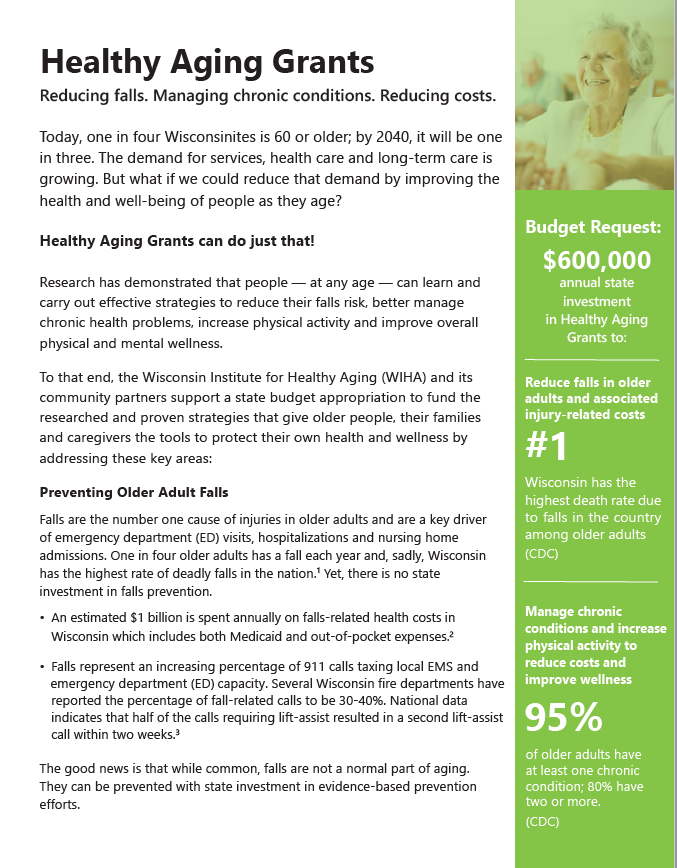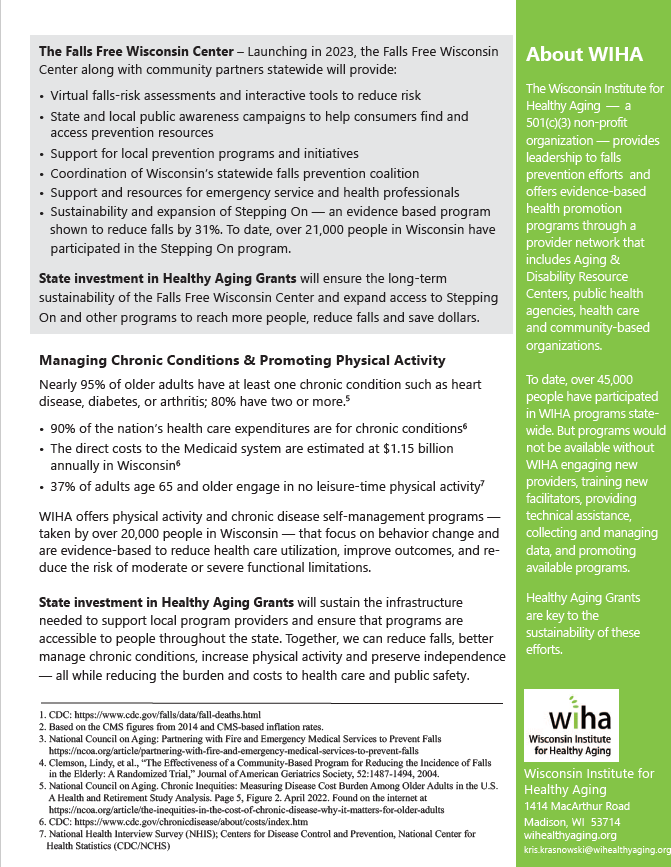Wisconsin’s Healthy Aging Grants: State Support for Older Adult Wellness and Independence
The proposed 2023-2025 budget includes $600,000 per year over the biennium for Healthy Aging Grants – funds to support evidence-based health promotion programs in communities throughout the state. These critically-needed funds could sustain the falls prevention, chronic disease self-management, and physical activity initiatives of WIHA and its community partners.
Our Ask: Please contact your state legislators (and encourage others to do so) beginning now through May – in person, at local listening sessions, via letter, phone call, e-mail. Use your own words and whenever possible include your personal experience – or that of someone you know – with falls prevention or healthy aging programs or initiatives. Find Your State Legislator
What would Healthy Aging Grants do?
Healthy Aging Grants can provide funding to support a statewide network of researched and proven programs for the safety and health of people as they age. WIHA, through a network of local providers (aging offices and ADRCs, health systems, senior centers, public health, physical activity centers and others) offers programs in falls prevention, chronic disease self-management, and physical activity.
Programs and initiatives that this grant could help sustain: Falls Prevention: Falls Free Wisconsin Center & Stepping On (falls prevention program) Managing Chronic Conditions: Living Well with Chronic Conditions, Healthy Living with Diabetes, Healthy Living with Chronic Pain, Mind Over Matter (incontinence program) Physical Activity: Physical Activity for Lifelong Success, Walk With Ease, Stand Up for Your Health.
Why healthy aging programs and initiatives are important:
- Wisconsin has the highest rate of deadly falls in the country. One in four older adults has a fall every year. Wisconsin County-Level Falls Data
- An estimated $1 billion is spent annually in Wisconsin for Medicaid and out of pocket costs due to falls-related health care.
- Older adult falls have a significant impact on public safety (EMS, Fire, ED)
- Oshkosh Fire Department – 21.4% of calls were for older adult falls
- 95% of older adults have one chronic condition, 80% have two or more
- 90% of the nation’s health care costs are for chronic conditions; in Wisconsin the direct costs to Medicaid are about $1.15 billion annually.
Why healthy aging programs and initiatives (such as the Falls Free Wisconsin Center) are good for Wisconsin:
- Promote self-management, behavior change and encourage older adults to take charge of their health and safety.
- Improve health, reduce costs. Examples include:
- Stepping On – reduced falls by 31%
- Healthy Living with Diabetes – reduced A1C levels, reduced ED visits by 53%
- Stand Up for Your Health – Reduced sedentary behavior by 68 minutes a day, reduced pain and reduced problems performing daily activities.
- Walk with Ease – reduced arthritis pain; increased balance and strength
- Reach people in their own communities, in accessible locations (senior centers, libraries, county centers, health centers, churches) with providers they know and trust.
- Expand the reach, visibility and accessibility of falls prevention practices through a robust falls prevention campaign and virtual interactive demonstrations of:
- How to spot and eliminate falls hazards in the home
- Balance & strength exercises
- How medications, footwear, vision, hearing affect falls risk
- How to safely get up after a fall
- Resources and effective strategies used by local community coalitions
How this helps local communities:
Details of the allocation are not spelled out but it is hoped that dollars will be used to:
- Strengthen and expand training and support to grow the number of evidence-based prevention classes, facilitators, and participants throughout the state
- Provide resources, funding and support for local falls prevention efforts, build falls prevention coalitions and test collaborative strategies to reduce falls
- Provide localized falls, chronic disease and cost data to strengthen targeted outreach
- Provide materials and resources that can be customized for local needs and connect consumers to local help
If you have questions, please us at info@wihealthyaging.org



